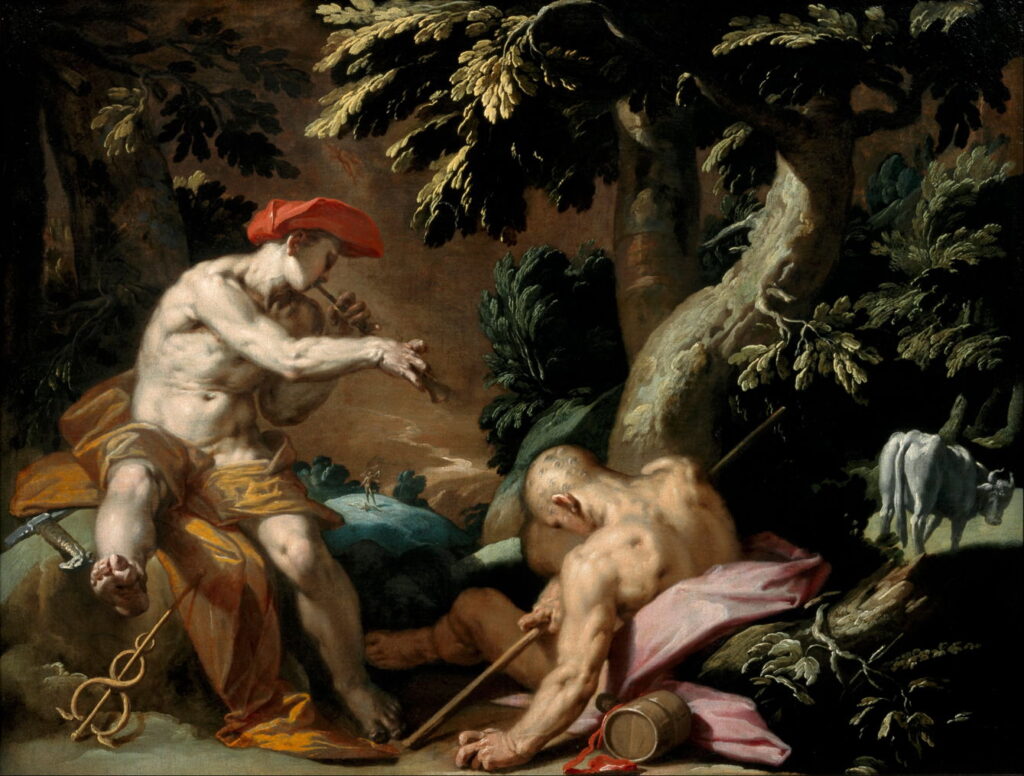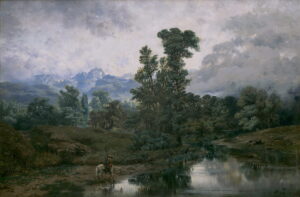Changing Paintings: 4 Io as a cow, the eyes of Argus, and Syrinx

After Apollo’s attempt to rape Daphne, who was turned into the laurel, Ovid tells us three myths with four metamorphoses ingeniously embedded into a single story. He leads into this by stating that, as Daphne was the daughter of the river-god Peneus, so Io was the daughter of the river-god Inachus.
The outermost story consists of Jupiter’s rape of Io, who he then transforms into a white cow for safe keeping. This leads to the embedded story of Mercury killing Argus, whose hundred eyes are used to transform the peacock’s feathers. Within that, Mercury tells Argus the story of Pan’s attempt to rape Syrinx. Finally, Io is transformed back to human form, and leads onto Ovid’s next myth.
Jupiter meets Io when she is out walking, and taking a fancy to her, offers to lead her safely through the hazards of the forest, a feeble excuse for leading her there to rape her. Io flees from him, but Jupiter brings her to a halt, then transforms himself into a dense cloud, and commits the rape.
Correggio (Antonio Allegri) (1489-95), Jupiter and Io (1520-40), oil on canvas, 162 x 73.5 cm, Kunsthistorisches Museum, Vienna, Austria. Wikimedia Commons.
Correggio took on the challenge of depicting Jupiter raping Io, and came up with a subtle approach in his Jupiter and Io from 1520-40. Jupiter has here become part of the clouds that he used to cloak his adultery, and his rape is depicted as a seduction.
John Hoppner (1758–1810), Jupiter and Io (1785), oil on canvas, 127 × 101.5 cm, Denver Art Museum, Denver, CO. Wikimedia Commons.
John Hoppner’s much later Jupiter and Io from 1785 takes a similar approach, and perpetuates the misinterpretation of it being consensual.
Juno, watching from the heavens, suspects that her husband is once again up to no good, so she descends to earth and dispels the clouds that had stopped Io’s flight and concealed her rape. Knowing that his wife is on his trail, Jupiter quickly transforms Io into a white cow, which only increases Juno’s suspicion, so she asks to be given the cow. Trapped, he has no option but to make a gift of Io to his wife, who then entrusts the cow to the care of the ever-watchful Argus, with his hundred eyes.
Io’s life as a cow comes as a shock to her, and makes her miserable. She manages to communicate her name to her father by scratching it out with a hoof, but Argus then removes her to a mountain to graze. Jupiter takes pity on Io, and devises a way of getting her back, by calling Mercury to kill Argus.
Mercury’s first task is to lull Argus to sleep. He tries playing his reed (‘Pan’) pipes, but then has to resort to telling him the story of Pan lusting and chasing after the beautiful Naiad Syrinx.
Abraham Bloemaert (1564–1651), Mercury, Argus and Io (c 1592), oil, 63.5 x 81.3 cm, Centraal Museum, Utrecht, The Netherlands. Wikimedia Commons.
The most popular scene from these interlinked stories is that of Mercury lulling Argus to sleep, although few depict Argus having the hundred eyes specified by Ovid. Abraham Bloemaert is an exception, in his carefully composed Mercury, Argus and Io from about 1592. Mercury is playing his flute at the left, as Argus falls asleep in front of him, his additional eyes visible over the surface of his head. In the distance at the right is Io as a white cow.
Jacopo Tintoretto (c 1518-1594), Mercury and Argus (1541-42) (E&I 20), oil on panel, dimensions not known, Galleria Estense, Modena, Italy. Image by Sailko, via Wikimedia Commons.
In his Mercury and Argus from 1541-42, Jacopo Tintoretto has chosen the same time, with Mercury playing a flute-like instrument, but Argus doesn’t look too sleepy yet.
Part way through this, Mercury has already put Argus to sleep, but Ovid completes the story of Pan and Syrinx for the the sake of the reader.
When Pan’s pursuit of Syrinx has almost succeeded, Syrinx implores her sisters to transform her. Just as Daphne before, by the time Pan reaches her, she has been turned into reeds, leaving Pan clutching at them. When Pan sighs, those reeds are blown by the wind and emit their distinctive sound, so that her name is given to pipes made from her reeds.
François Boucher (1703–1770), Pan and Syrinx (1743), oil on canvas, 101 × 133 cm, Private collection. Wikimedia Commons.
The story of Pan and Syrinx has also proved popular in visual art. François Boucher seems to have painted it many times, and his Pan and Syrinx from 1743 is probably his finest version, even though it only alludes to her transformation rather than showing it.
Peter Paul Rubens (1577–1640), Pan and Syrinx (c 1636), oil on panel, 27.8 × 27.8 cm, Musée Bonnat-Helleu, Bayonne, France. Wikimedia Commons.
Peter Paul Rubens’ late oil sketch of Pan and Syrinx from about 1636 is one of the few that attempts to show Syrinx undergoing her transformation, and makes Pan appear thoroughly lecherous.
Diego Velázquez (1599–1660), Mercury and Argus (c 1659), oil on canvas, 127 x 250 cm, Museo Nacional del Prado, Madrid. Wikimedia Commons.
Returning to the outer story, perhaps the most famous painting of Mercury and Argus is that of Velázquez from about 1659, the year before he died. The two figures are shown in contemporary dress, with Mercury just about to raise his sword and decapitate the sleeping Argus. Behind them is Io, not white but tan in colour.
Once his victim is sound asleep, Mercury beheads Argus and throws his head from a cliff, ending his watch over Io the cow. Juno then puts his hundred eyes on the feathers of her peacocks, where they are transformed to form their distinctive appearance.
Peter Paul Rubens (1577–1640), Juno and Argus (c 1611), oil on canvas, 249 × 296 cm, Wallraf-Richartz-Museum & Fondation Corboud, Cologne, Germany. Wikimedia Commons.
Rubens painted several fine versions of Mercury about to kill Argus that omit his extra eyes. His other superb painting of this story is Juno and Argus from about 1611, showing the outcome. Juno, wearing the red dress and coronet, is receiving eyes that have been removed from Argus’ head, and is placing them on the tail feathers of her peacocks. The headless corpse of Argus lies contorted in the foreground. Rubens took the opportunity of adding a visual joke, in which Juno’s left hand appears to be cupped under the breasts of the woman behind.
Jean-François Millet (1814–1875), Mercury Leading the Cows of Argus to Water (study for) (1846-1848), oil on canvas, 44.5 × 65.4 cm, Los Angeles County Museum of Art, Los Angeles, CA. Wikimedia Commons.
Jean-François Millet’s study for Mercury Leading the Cows of Argus to Water was probably painted between 1846-48. Mercury is here leading a white cow, presumably Io, away from the sleeping Argus, in an unusual variation of Ovid’s account.
Juno expresses her anger at Io the cow, eventually driving her as far as the river Nile in Egypt. Jupiter and Juno then make peace, and the king of the gods promises his wife that Io will trouble her no more, as Io is transformed back into human form, and finally plucks up the courage to speak instead of mooing. Io then becomes worshipped as a goddess by the people of Egypt, as is the son she bore by Jupiter, Epaphus, who was a friend and contemporary of Phaëthon, son of Phoebus, and the subject of Ovid’s next story.
Bartolomeo di Giovanni (1480-1510), The Myth of Io (c 1490), tempera and oil on wood panel, 65 x 171.5 cm, Walters Art Museum, Baltimore, MD. Wikimedia Commons.
Less well-known but in many ways the most remarkable depiction of Ovid’s complex stories, Bartolomeo di Giovanni’s panel The Myth of Io (c 1490) is believed to have had a companion which told the first part of the story using a similar multiplex narrative technique.
This wonderful surviving panel tells the second part, after Io has been transformed into a cow, although he shows her as being light brown. At the left, Jupiter (in the clouds) directs Mercury (carrying his caduceus) to free Io the cow from the watchful eyes of Argus (shown with a red cloak). Mercury takes a flock up the hill to Argus, where he sits with Argus and puts him to sleep. Once asleep (centre), Mercury beheads Argus, and gives Juno his head to place its eyes on her peacocks (bottom centre).
Io the cow is then driven by three naked Furies to the River Nile, at the right, where she is returned to human form and flees under the sight of Jupiter and Juno making peace with one another.




